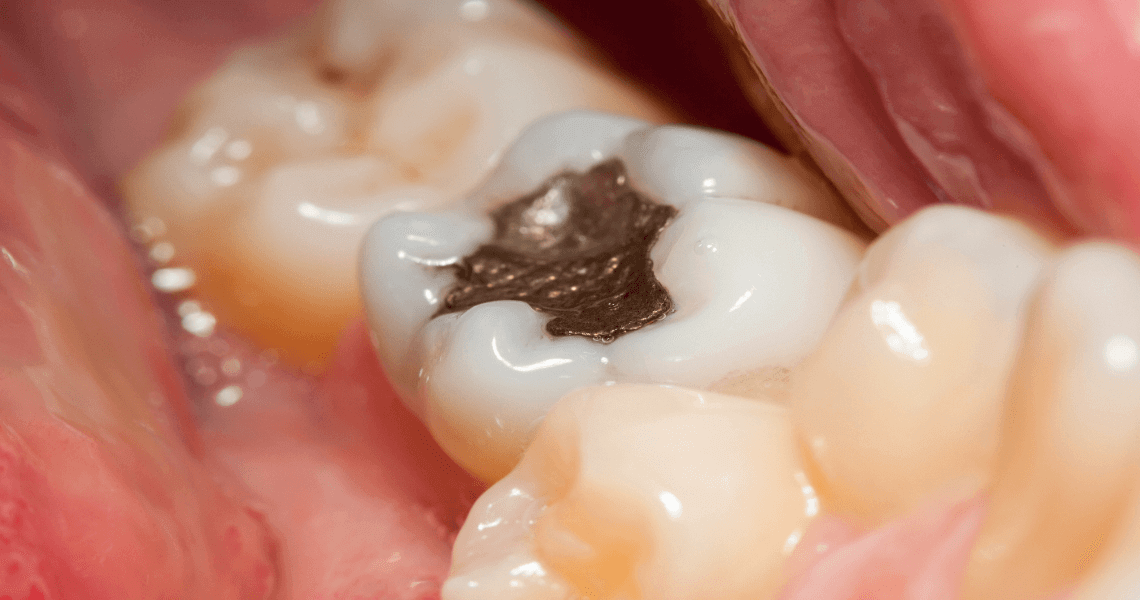What Is Amalgam?
The amalgam is a mixture of different metals that consist of liquids like – mercury and powdered alloy composite of copper and silver. More than half of amalgam fillings use mercury by weight. The many chemical properties of elementary mercury cause a reaction that binds copper and silver particles together, forming a complete amalgam for the filling procedure. Then this amalgam is generally used to fill in the cavities that are caused by tooth decay. It is also known as silver fillings because they have a silver-like appearance.
- In this procedure, the dentist will drill the tooth to remove the decay and reshape the cavity for placement of the amalgam filling.
- Next, the dentist will mix the liquid mercury with the encapsulated powder form of alloy that forms the base of the amalgam.
- The soft amalgam is then placed on your prepared cavity, which hardens to form a solid filling.
The use of metals is always a growing cause of concern in the health sector as today’s environment may have a different impact on your body compared to previous generations.
Dentists and patients always request the removal of amalgam-based fillings due to high mercury content. A safe protocol to replace the silver mercury filling will ensure the materials are not absorbed while removing.
There are many strong amalgam filling replacement options that are available after the removal process. The new lab processed materials that are available can help create a healthy environment for the mouth.
Learn more about White Fillings on the Sunshine Coast here.
Looking for a Safer Alternative to Amalgam Fillings?
Schedule an Appointment and Take the First Step Towards a Healthier Smile!
Are Amalgam Fillings dangerous?
Amalgam fillings, also known as “silver fillings,” have been a topic of concern regarding their safety due to their mercury content. However, according to the FDA and various research studies, there is no evidence that the mercury released from amalgam fillings results in adverse health effects in the general population.
While precautions are taken with amalgam due to low-level mercury vapour release, most evidence suggests that exposure to dental amalgam doesn’t cause health issues for the general population.
Why Is The Safe Removal Of Mercury Amalgam Fillings Important
Deciding whether to remove mercury-based amalgam fillings is complex, and requires careful consideration of multiple factors. One of which is to check if your filling is in good condition or not. If you are not able to identify it, reach out to your dentist or healthcare professional and get it checked. If there are no signs of decay beneath the filling, it is not recommended to remove your amalgam filling. The removal of intact amalgam fillings may result in the unnecessary loss of healthy tooth structure, which can expose you to a temporary increase in mercury vapour during the removal process.
Always consider professional advice, particularly for those at higher risk, such as pregnant or nursing mothers and children. You should replace it only when there is decay beneath the filling, it’s worn out or broken. And go for removal only when it is medically necessary and asked by a qualified professional.
Mercury Amalgam Fillings: Risks and Symptoms
Over time, mercury amalgam fillings may begin to degrade or leak, releasing mercury vapour into the body. Research suggests that more than 80% of this vapour can be absorbed through the lungs and distributed throughout the system, potentially contributing to toxic buildup.
The effects of mercury exposure vary from person to person and depend on factors like individual sensitivity, the number of fillings, and existing health conditions. While not everyone with amalgam fillings will experience symptoms, some may develop issues linked to chronic low-level mercury exposure.
Common symptoms associated with mercury exposure include:
- Fatigue
- Headaches
- Anxiety or mood swings
- Difficulty concentrating
- Memory loss
- Tremors
- Skin rashes
- Gastrointestinal discomfort
- Widespread joint or muscle pain
- Decreased coordination or fine motor control
- Sensory changes, including reduced vision or colour perception
The risks of long-term exposure can range from mild to significant, particularly in individuals who are more vulnerable, such as children, pregnant women, or those with compromised immune systems. If you are experiencing any of these symptoms and suspect your fillings may be contributing, it’s essential to consult a healthcare professional or a qualified mercury filling removal dentist.
Safe Amalgam Filling Removal Procedure
The Whole Removal Process
In this procedure, dentists follow a safe mercury filling removal protocol to remove silver fillings while keeping the patients and staff safe from mercury exposure. The challenge faced is you may ingest some mercury during the process which can travel through your digestive tract and affect your immune system, increasing the level of heavy metal toxicity in your body.
To ensure patient safety during amalgam filling removal, several precautions are taken. Patients are provided with safety glasses, and a nasal cannula tube is inserted to facilitate breathing while minimizing exposure to mercury vapour. A dental mask covers the nose, preventing mercury vapour from entering the nostrils. Additionally, a rubber dam or isolate is placed in the patient’s mouth to prevent mercury from going down the throat. A high-volume suction device is employed to efficiently remove particles generated during the drilling process.
The Replacement Process
When you’re planning for the replacement of your dental amalgam filling, it’s important to discuss the procedure with your dentist. The process involves several safety protocols to ensure a smooth replacement. A non-latex dental dam is used to isolate the area, providing a barrier. Your nose is covered for airway protection, and there is pressurized air under the dam to ensure a continuous air supply for breathing. Suction is a critical step both in front and behind the dam to manage any particles. The room environment requires an efficient exhaust system, and the air conditioning system should have an external vent. Moreover, for added safety throughout the process, the dentist and assisting dental staff wear protective masks.
When the Process is Complete
When dentists take out mercury fillings safely, patients don’t experience any metal taste in their mouths. This helps them concentrate better, and their bodies respond well to other treatments. After removing the fillings, eating the right foods for detoxification makes many patients feel better within two or three days.
Also, after the process of removal, most people look for the replacement of metal fillings. The most common type of replacement is tooth-coloured composite resin filling. Composite is a better cosmetic option as it’s completely free from any kind of metal, including mercury. It also bonds well to the tooth structure allowing conservative dentistry.
Further reading: Best And Worst Foods For Your Teeth
Why Should You Remove Mercury Amalgam Fillings?
Multiple factors are taken into consideration when amalgam removal is requested. These factors include the rate of wear, your diet and lifestyle, normal pressure that is exerted, oral hygiene, and other metals in the mouth.
- Dental restoration often involves addressing issues like crowns and amalgam discolouration near the gums. Amalgams are used to seal root canal teeth, but clenching and grinding may compromise composite restoration longevity.
- The restoration process’s material choice is influenced by its size; normal tooth cusps may fracture over time, necessitating lab-fabricated indirect restorations under heavy pressure.
- A growing trend involves computer-generated restoration processes. Bite plates can prevent grinding and clenching, preserving new restorations from excessive pressure and wear.
When the patient visits the dentist for an examination, the dentist will check the entire dental history. Records that include dental X-rays and radiographs are taken before the process. A comprehensive exam follows the results of the reports. Detailed discussion is carried out to make sure patients are well-prepared for the procedure. This helps them understand everything and feel confident before going through it.
- The dentist evaluates the overall health of the patient and the ability to eliminate toxins.
- If a woman is pregnant or breastfeeding a child, then the process of removal is not completed until the breastfeeding is completed as the mercury concentration in the blood is thirty times greater than a mother’s milk.
- The dentist will also provide certain supplements before the removal process. Vitamin C is the most recommended supplement along with others.
Removing silver fillings or replacing them with non-toxic fillings is the most common procedure. Make sure you always visit an experienced dentist who understands how to safely remove the amalgam fillings.
What Do You Need To Do After the Amalgam Removal Procedure?
Once the mercury is removed, the next step is to restore the tooth to its normal function. This involves filling the spaces left by the removed amalgam. The options for this step depend on the size of the filling and the condition of the treated tooth. The choices vary, based on the size of the filling and the condition of the treated tooth.
Similar to a dental crown, it ranges from a simple composite filling to a full restoration. Therefore, dentists conduct a compatibility test to determine which material suits your oral needs best, and it will vary based on the specific situation. Also, when you’ve decided to get the mercury fillings removed, ensure that you have it done by a qualified professional.
Choose a team that is well-trained, has good experience, and checks reviews on Google. Also, check if they follow all safety measures, as you don’t want any metal toxicity in your body.
Removing Amalgam Fillings Side Effects
You can feel sick after amalgam removal. The teeth might feel more sensitive to hot or cold things. You might also feel a bit of discomfort or mild pain, especially if the dentist has to remove a lot. Your gums or jaw might get a bit swollen or tender, but this usually gets better with time. Some people notice a weird metallic taste in their mouth right after the removal. You could also feel some pain after the removal but don’t worry, it usually doesn’t last long.
This happens because the removal process involves things like drilling, which can temporarily change how your teeth and gums feel. When your tooth has a larger amalgam filling and more extensive, deeper cracks, it’s more prone to becoming sensitive. Dentists take care to make the removal process as easy as possible for you, but it’s important to know that it may take some time and healing on your own.
What are The Benefits of Safe Removal of Mercury Fillings?
People deciding to switch out their silver fillings understand the benefits of removing mercury. Here are some potential benefits of removing amalgam fillings:
- Avoiding Mercury Exposure: The mercury filling removal process prevents continuous exposure and contact with mercury, addressing concerns about potential health risks.
- Peace of Mind: Patients often experience a sense of calm after removal, knowing their mouths are now free from mercury-containing materials.
- Improved Appearance: Swapping mercury fillings with tooth-coloured alternatives enhances the aesthetic appeal of teeth, potentially boosting self-confidence.
- Minimizing Health Risks: For those with symptoms related to mercury poisoning or concerns about health risks, removing mercury fillings is seen as a step to reduce potential risks.
Further Reading: Ways Your Dental Health Affects You
Amalgam Filling Removal Cost
When you’re thinking about getting rid of those mercury fillings, it’s important to remember that your dentist will first examine your mouth thoroughly. You must undergo some typical exams such as X-rays, intraoral pictures, and dental and medical history.
Before the procedure, the dentist will conduct a comprehensive exam to determine certain factors such as
- How many silver fillings need to be taken out?
- The size of those mercury fillings.
- The specific locations of these metal fillings in your oral cavity.
These factors play a significant role in determining the procedure’s cost and the cost may vary accordingly. So it’s important to discuss these details with your dentist to get a clear understanding of the potential costs involved. At Oris Dental, the amalgam filling removal costs start from $200.
Finding a Mercury Filling Removal Dentist
If you’re considering this procedure, it’s important to choose a qualified mercury filling removal dentist. At Oris Dental, we serve patients looking for safe amalgam removal from across the Sunshine Coast, including those searching for a trusted dentist in Kawana, a dentist in Caloundra, or a dentist in Maroochydore.
Conclusion
Times have changed and there are constant updates in the field of dentistry. Earlier mercury-based fillings were an ideal choice for cavities but not any more. Today, people prefer natural alternatives like a white composite filling for teeth.
To know more about amalgam teeth filling removal costs in Australia get in touch with your Sunshine Coast Dentist today.
Looking for a Safer Alternative to Amalgam Fillings?
Schedule an Appointment and Take the First Step Towards a Healthier Smile!
FAQs:
Q) Is amalgam filling removal safe?
Ans: Yes, amalgam filling removal can be safe if the right protocol is followed. However, it is not recommended to remove intact amalgam fillings unless they are broken, worn, or there is decay beneath them.
Q) What is the safest method to remove mercury amalgam fillings?
Ans: The safest method for removing mercury amalgam fillings is generally considered to be the MSART (Safe Mercury Amalgam Removal Technique) method. This method involves several precautions to minimise mercury exposure, using a rubber dam to isolate the tooth and suction the mercury vapours and debris.

Dr. Adarsh Pisharodi
Dr. Adarsh Pisharodi, serving as the principal dentist at Oris Dental, brings a wealth of expertise spanning over 26 years to his esteemed practice. Specializing in cosmetic dentistry, dental implants, and orthodontics, he takes immense pride in rejuvenating countless smiles and instilling confidence in Sunshine Coast residents. As an esteemed member of the Australian Dental Association and esteemed dental societies, he remains steadfast in delivering exceptional care to his patients.















